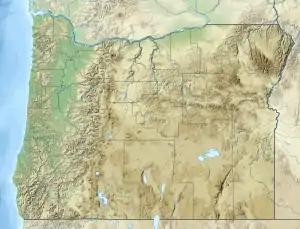Detroit Dam
Detroit Dam is a gravity dam on the North Santiam River between Linn County and Marion County, Oregon. It is located in the Cascades, about 5 mi (8.0 km) west of the city of Detroit. It was constructed between 1949 and 1953 by the United States Army Corps of Engineers. The dam created 400-foot (120 m) deep Detroit Lake, more than 9 miles (14 km) long with 32 miles (51 km) of shoreline.[4][5][6]
| Detroit Dam | |
|---|---|
.jpg.webp) Detroit Dam on the North Santiam River | |
 Location of Detroit Dam in Oregon | |
| Country | United States |
| Location | Detroit, Linn County/Marion County, Oregon |
| Coordinates | 44.7209556°N 122.2497972°W |
| Purpose | Flood control, power, irrigation |
| Status | Operational |
| Construction began | 1949 |
| Opening date | 1953 |
| Construction cost | $13,615,000 (1953 est.)[1] equiv. to $130 million today[2] |
| Owner(s) | U.S. Army Corps of Engineers |
| Dam and spillways | |
| Type of dam | Concrete gravity |
| Impounds | North Santiam River |
| Height | 463 ft (141 m) |
| Length | 1,523.5 ft (464.4 m) |
| Elevation at crest | 1,580 ft (480 m) |
| Reservoir | |
| Creates | Detroit Lake |
| Total capacity | 455,000 acre⋅ft (561,000,000 m3) |
| Active capacity | 321,000 acre feet (396,000,000 m3) |
| Catchment area | 437 sq mi (1,130 km2) |
| Surface area | 3,500 acres (14 km2) |
| Maximum length | 9 mi (14 km) |
| Normal elevation | 1,569 ft (478 m) (full) |
| Commission date | 1953 |
| Type | Conventional |
| Turbines | 2 x 100 MW Francis-type[3] |
| Installed capacity | 100 MW |
It is one of the dams authorized by the Flood Control Act of 1938.[7] Construction was delayed largely due to World War II. The dam, dedicated on June 10, 1953,[8] was authorized for the purposes of flood control, power generation, navigation, and irrigation. Other uses are fishery, water quality, and recreation. It was built in concert with the Big Cliff Dam downstream.[1]
 Free-overflow spill test, 2013
Free-overflow spill test, 2013 Top of Dam
Top of Dam
Capacity
- Drainage area: 437 mi² (1,132 km²)
- Maximum inflow: 63,200 ft³/s (1,790 m³/s) 1909
- Lake Elevation
- Maximum pool: 1,574 ft (480 m)
- Full pool: 1,569 ft (478 m)
- Minimum flood control pool: 1,450 ft (442 m)
- Usable storage (1,425.0 to 1,563.5 ft) = 321,000 acre feet (396,000,000 m3)
- Powerhouse
- Number of units: 2
- Nameplate capacity: 100 MW
- Overload capacity: 115 MW
- Hydraulic capacity: 5,340 ft³/s (151 m³/s)
References
- Bob Reinhardt (June 10, 2019). "Detroit Dam". Oregon Encyclopedia. Retrieved 2011-06-10.
- Federal Reserve Bank of Minneapolis. "Consumer Price Index (estimate) 1800–". Retrieved January 1, 2020.
- JP Duncan, TJ Carlson (May 2011). "Characterization of Fish Passage Conditions through a Francis Turbine, Spillway, and Regulating Outlet at Detroit Dam, Oregon, Using Sensor Fish, 2009" (PDF). U.S. Army Corps of Engineers. Retrieved 10 January 2015.
- "Detroit Dam". Geographic Names Information System. United States Geological Survey. Retrieved 2006-05-03.
- "The Detroit and Big Cliff Dams". North Santiam Water Council. 12 June 2012. Retrieved 10 January 2015.
- "Building Strong® at Detroit Dam and Reservoir". U.S. Army Corps or Engineers. Retrieved 10 January 2015.
- United States. Army. Corps of Engineers. Civil Works Directorate (1976). Annual Report of the Chief of Engineers on Civil Works Activities. p. 37-29. Retrieved May 6, 2020.
... for construction under general authorization Willamette River Basin in 1938 Flood Act. 1948 Flood Control Act modified project to provide for installation of power generating facilities including construction of a reregulating dam ...
- "Detroit". North Santiam Chamber of Commerce. Retrieved 2011-06-10.
External links
| Wikimedia Commons has media related to Detroit Dam. |
- Corps of Engineers plots of lake level and flow for various intervals up to a year